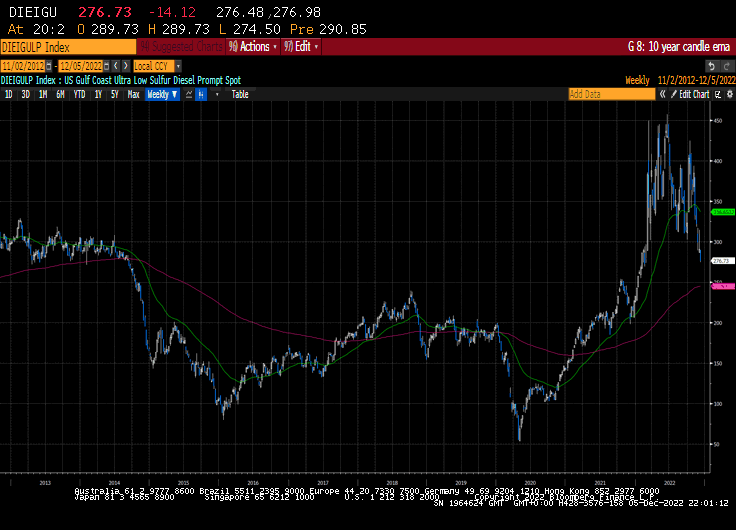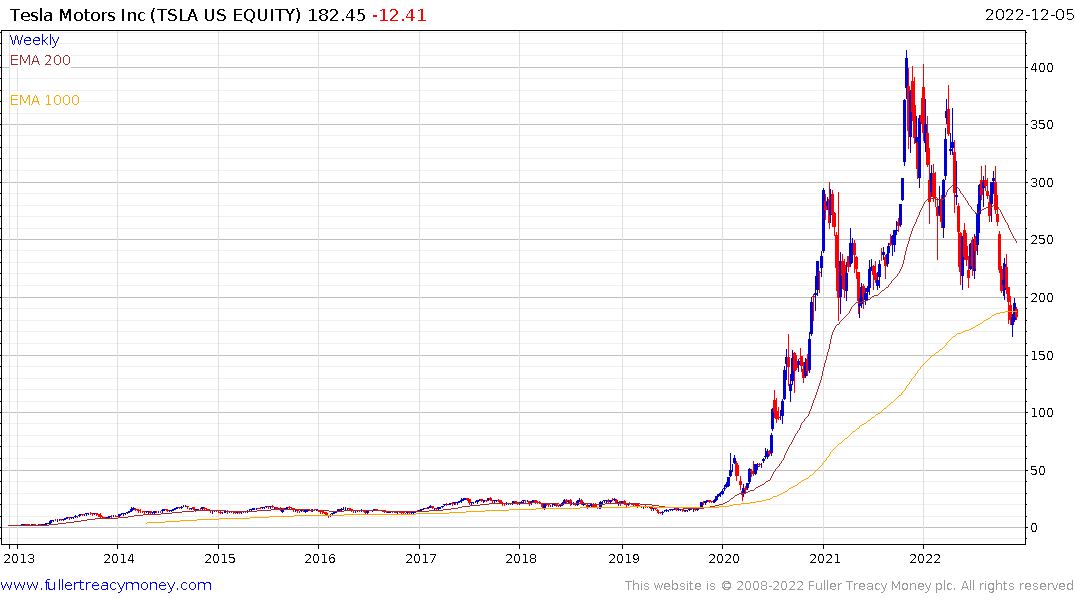Musk's Last Laugh With Impossible Electric Truck
This article from Bloomberg may be of interest to subscribers. Here is a section:
The first working models of the Semi were delivered last week to PepsiCo Inc., part of an order of 100 vehicles. That’s three years behind schedule, but it still happened. More sober carmakers are getting in on the act, too. Alongside Volvo, Daimler Truck Holding AG has had orders for 1,280 zero-emission trucks and buses in the first half of this year, and unveiled a prototype long-haul model in September.
What’s changed? If Tesla had made dramatic breakthroughs in battery density, Musk would be boasting about it, so that's not the answer. There’s one huge difference in 2022 compared to 2017, however: the cost of diesel.
The decline of domestic oil refining and 2022’s squeeze in energy prices have conspired to drive US truck fuel costs up to almost double what they were five years ago. Plug the current prices of Californian diesel and commercial electricity into the trucking expenditure calculator made by logistics-data company ACT Research Co., and even an electric rig that’s twice as pricey to buy as a conventional vehicle is getting 12% cost savings every mile, equivalent to nearly $17,000 a year at typical usage levels.1
That might not last as diesel prices fall back to earth, but it’s close enough to put electric trucking firmly in the game.
The other factor supporting the Semi right now is that it’s not trying to offer full-spectrum competition to long-haul trucks. Its range is only half what a Class 8 can do between refueling stops. It’s telling, too, that one of its first customers will be a Frito-Lays plant. If you’re worried about the challenges of hauling heavy loads as well as your massive batteries, few types of cargo will be more forgiving than feather-light pallets of potato chips.
The first thing that comes to mind is virtue signalling. Putting a few hundred or thousand large electric haulage vehicles on the road will help reduce emissions inside cities. They will be visible to large numbers of people and everyone will feel good about “helping” the environment. Meanwhile the heavy lifting of haulage will continue to depend on diesel.
It would be easy to conclude that law of unintended consequences was at play when the IMO2020 shipping rules barred the use of bunker fuel in the global shipping fleet. That pushed shipping demand for fuel up the crack column into middle distillates which includes diesel. The net result has been to create a massive new source of demand diesel, at exactly the same time refineries are being shut down and Russian supply is no longer appetising.
Perhaps that was the aim of the rule change all along, but the net effect is a significant supply inelasticity situation for diesel. For now, the price is declining because container rates are collapsing, the USA’s rail strike has been avoided for now, and liquidity conditions continue to tighten. That suggests scope for weakness but also potential for a significant rebound when economic recovery takes hold.
I am reminded for the bullish case for palladium and catalytic converters. In normal circumstances substitution for platinum would have been viable years ago. The automotive industry did not see the need to invest in the necessary supply chain alternations because they are planning to build more EVs and expect demand for catalytic converters to decline. The result is palladium rose from $500 to $3000 between 2016 and the peak in 2021.
 Diesel does not have the same supply inelasticity issues as relatively rare metal like palladium. However, refining capacity takes time to build and that is very unlikely to happen in Europe or North America. It suggests Reliance Industries in India remains in an attractive position.
Diesel does not have the same supply inelasticity issues as relatively rare metal like palladium. However, refining capacity takes time to build and that is very unlikely to happen in Europe or North America. It suggests Reliance Industries in India remains in an attractive position.
The other significant announcement that accompanied the rollout of the Tesla semi is it will take a 1MW charger. That’s a lot of electricity supplied over a short period of time and suggests significant grid pressure. That’s especially true of the Cybertruck which is expected to have the same kind of battery pack but to sell in much higher volumes.
 Tesla continues to ease back from the psychological $200 area and the region of the 1000-day MA. This remains a medium-term downtrend.
Tesla continues to ease back from the psychological $200 area and the region of the 1000-day MA. This remains a medium-term downtrend.


